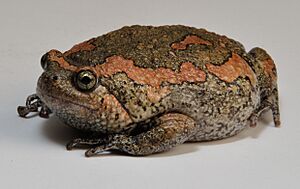Sri Lankan bullfrog facts for kids
Quick facts for kids Sri Lankan bullfrog |
|
|---|---|
 |
|
| Conservation status | |
| Scientific classification | |
| Synonyms | |
|
The Uperodon taprobanicus, also known as the Sri Lankan bullfrog or Indian painted frog, is a type of narrow-mouthed frog. You can find this frog in countries like Nepal, Bangladesh, India, and Sri Lanka. It lives in areas up to about 1300 meters (about 4,265 feet) high.
This frog can grow up to 75 millimeters (about 3 inches) long from its nose to its rear end. Scientists first described it in 1934. The IUCN (International Union for Conservation of Nature) says this frog is of "Least Concern". This means it is not currently in danger of disappearing.
Contents
How Scientists Classify This Frog
Scientists are always learning new things about how living things are related. For a while, this frog was thought to be a type of Kaloula frog. It was called Kaloula taprobanica.
However, after more studies, scientists like Peloso and his team in 2016 found that it was more closely related to frogs in the Uperodon group. So, they moved it to the Uperodon family. This is why its scientific name is now Uperodon taprobanicus.
What This Frog Looks Like
This frog is quite plump. Female frogs are usually a little bigger than males. They can grow to about 75 millimeters (3 inches) long.
The top of the frog's body is a grayish-black color. It has cool reddish-brown patches on both sides that are the same shape. There's also a colored stripe that goes from behind its eye to its arm. The frog's belly is a light yellowish-gray. It often has black or brown spots. During the time they breed, male frogs get a dark patch on their throat.
Where This Frog Lives and Its Home
The Uperodon taprobanicus frog is native to Sri Lanka, India, Bangladesh, and Nepal. It is most common in southern India and Sri Lanka. This frog has also been found in some parts of Gujarat and Rajasthan in India.
In India, you can find it in many states. These include West Bengal, Odisha, Assam, Karnataka, Kerala, Telangana, Tamil Nadu, and Andhra Pradesh. It is very common in the southern areas of the Western Ghats and Eastern Ghats mountain ranges. In Sri Lanka, it lives all over the island, from sea level up to 1300 meters high.
This frog is a fossorial species. This means it likes to spend its day buried. It might hide in leaf litter, loose soil, or under fallen logs. But it can also climb up into tree branches! It likes to live in dry forests, coconut and rubber farms, wetlands, and even rice fields. It can also be found in areas near human homes.
Frog Behaviour and Life Cycle
This frog enjoys eating many different kinds of insects. When the rainy season starts, it's time for these frogs to breed. The male frogs will call out from water bodies to attract females.
When the eggs are laid, they float on the surface of the water in a single layer. The young tadpoles that hatch from the eggs are black.
Unusual Friendships
Did you know that this frog can have a very unusual friend? Scientists have seen an Uperodon taprobanicus frog living with a Poecilotheria tarantula. Tarantulas are large spiders that can be aggressive. They are certainly big enough to eat small frogs.
But in this case, the spider and frog helped each other! The tarantula might protect the frog from other animals that want to eat it. In return, the frog might protect the spider's eggs from tiny ants. This is a type of mutualistic relationship, where both animals benefit.
Scientists saw the frog and tarantula come out of the same tree hole. They stood close to each other, and the tarantula did not try to eat the frog. This shows a surprising friendship in nature!
The presence of Uperodon taprobanicus frogs in an area often means that the place is healthy. It can show that the area supports other rare or special animals too.
Conservation Status
This frog lives in many places, and its population seems to be quite stable. The IUCN has listed it as being of "Least Concern". This means they believe the frog's numbers are not going down fast enough to be worried about it becoming endangered.
Even though it's common, there are still some things that could harm this frog. These include its home (habitat) being damaged. Also, pollution from farm chemicals in the water where it breeds can be a problem.
Images for kids





